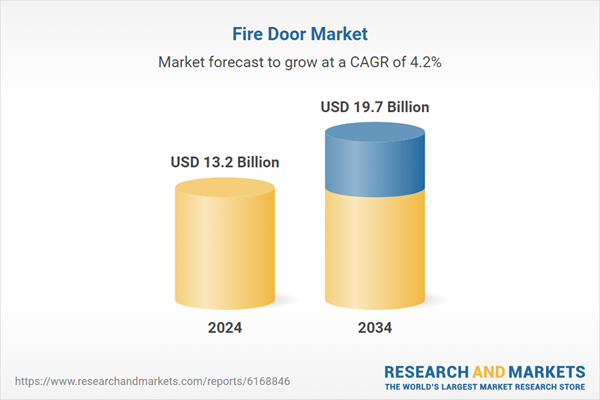Governments and regulatory bodies across the globe are tightening fire safety standards in response to the growing number of fire-related incidents and rising concerns over building safety. Building codes such as the International Building Code (IBC), National Fire Protection Association (NFPA) standards in the U.S., and similar regulations in Europe and Asia mandate the installation of fire-rated doors in the residential and commercial properties.
Rising Adoption of Hinged Fire Door
The hinged fire doors segment held substantial share in 2024, owing to their proven reliability, simplicity, and wide applicability across residential, commercial, and industrial settings. These doors are favored for their ease of use and strong sealing capabilities, making them ideal for containing fire and smoke within specific zones during emergencies. As builders seek cost-effective and code-compliant fire safety solutions, hinged fire doors offer a versatile option with high fire ratings and customizable designs.Rising Prevalence of Timber
The timber fire doors segment generated notable share in 2024 driven by fire resistance with aesthetic appeal, especially in upscale residential and hospitality projects. With modern treatments and fire-retardant cores, timber fire doors can now meet rigorous safety standards while maintaining a warm, natural finish that aligns with interior design trends. The growing emphasis on sustainable materials are in favor of engineered timber solutions in the fire-rated category.Interior to Gain Traction
The interior fire door segment held robust share in 2024 driven by in-building fire compartmentalization. These doors are essential for preventing the rapid spread of flames and smoke between rooms, stairwells, and hallways especially in multi-family housing, offices, and healthcare facilities. With building codes now mandating the use of interior fire doors in specific zones, demand is rising for solutions that combine fire resistance with sleek finishes and design flexibility.Regional Insights
Asia-Pacific to Emerge as a Lucrative Region
Asia-Pacific fire door market held sizeable growth in 2024, owing to booming construction activity and evolving safety regulations. Countries like China, India, Japan, and South Korea are witnessing a surge in urban infrastructure development, commercial real estate, and high-rise residential projects all of which are driving the need for certified fire safety solutions. As governments tighten fire safety codes and enforcement, demand for fire-rated doors is accelerating across both new construction and retrofit markets.Major players in the fire door market are Rapp Bomek, Chase Doors, Fusim Group, UK Fire Doors, Vista Panels, Esserford Joinery Works, Mesker Openings Group, China Buyang, ASSA ABLOY, Agta Record, Taotao Group, National Firefighting Manufacturing, Republic Doors and Frames, Nihon Funen, Hormann Beteiligungs.
To stay competitive and expand their reach, fire door manufacturers are employing a mix of strategic initiatives. Product innovation and certification remain central, with companies focusing on developing advanced fire-rated doors that meet international safety standards while offering design flexibility. Many are investing in sustainable and eco-friendly materials to align with green building trends and regulatory requirements. Mergers, acquisitions, and strategic partnerships are also being pursued to enter new markets and broaden product portfolios. At the same time, firms are enhancing their distribution networks and after-sales services to improve customer experience and build brand loyalty.
`
Comprehensive Market Analysis and Forecast
- Industry trends, key growth drivers, challenges, future opportunities, and regulatory landscape
- Competitive landscape with Porter’s Five Forces and PESTEL analysis
- Market size, segmentation, and regional forecasts
- In-depth company profiles, business strategies, financial insights, and SWOT analysis
This product will be delivered within 2-4 business days.
Table of Contents
Companies Mentioned
The key companies profiled in this Fire Door market report include:- Agta Record
- ASSA ABLOY
- Chase Doors
- China Buyang
- Esserford Joinery Works
- Fusim Group
- Hormann Beteiligungs
- Mesker Openings Group
- National Firefighting Manufacturing
- Nihon Funen
- Rapp Bomek
- Republic Doors and Frames
- Taotao Group
- UK Fire Doors
- Vista Panels
Table Information
| Report Attribute | Details |
|---|---|
| No. of Pages | 250 |
| Published | August 2025 |
| Forecast Period | 2024 - 2034 |
| Estimated Market Value ( USD | $ 13.2 Billion |
| Forecasted Market Value ( USD | $ 19.7 Billion |
| Compound Annual Growth Rate | 4.2% |
| Regions Covered | Global |
| No. of Companies Mentioned | 16 |









